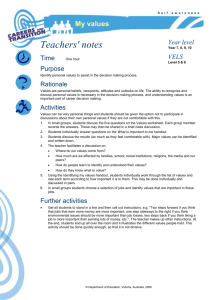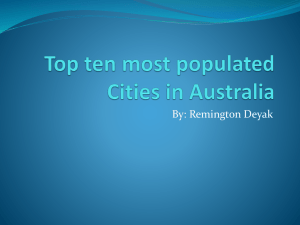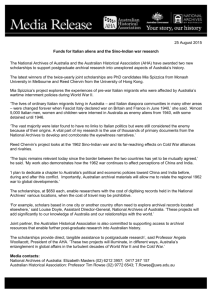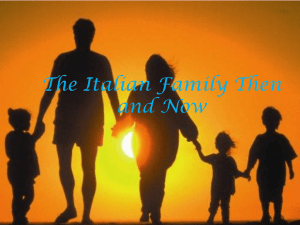ITALIAN HISTORICAL SOCIETY
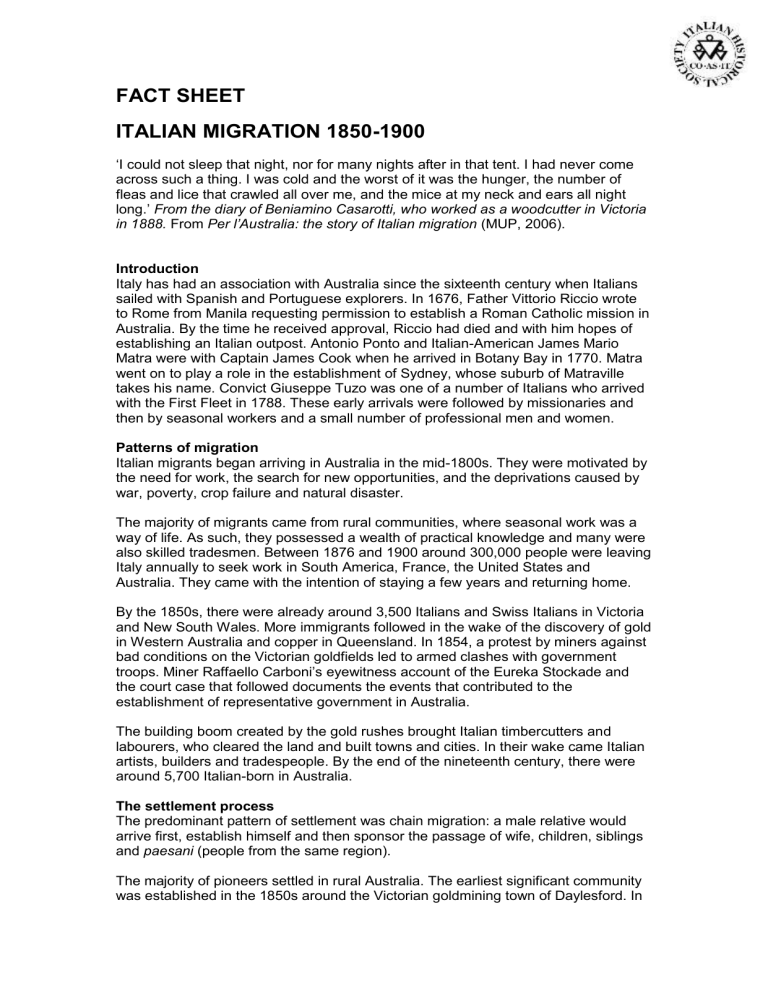
FACT SHEET
ITALIAN MIGRATION 1850-1900
‘I could not sleep that night, nor for many nights after in that tent. I had never come across such a thing. I was cold and the worst of it was the hunger, the number of fleas and lice that crawled all over me, and the mice at my neck and ears all night long.’ From the diary of Beniamino Casarotti, who worked as a woodcutter in Victoria in 1888. From Per l’Australia: the story of Italian migration (MUP, 2006).
Introduction
Italy has had an association with Australia since the sixteenth century when Italians sailed with Spanish and Portuguese explorers. In 1676, Father Vittorio Riccio wrote to Rome from Manila requesting permission to establish a Roman Catholic mission in
Australia. By the time he received approval, Riccio had died and with him hopes of establishing an Italian outpost. Antonio Ponto and Italian-American James Mario
Matra were with Captain James Cook when he arrived in Botany Bay in 1770. Matra went on to play a role in the establishment of Sydney, whose suburb of Matraville takes his name. Convict Giuseppe Tuzo was one of a number of Italians who arrived with the First Fleet in 1788. These early arrivals were followed by missionaries and then by seasonal workers and a small number of professional men and women.
Patterns of migration
Italian migrants began arriving in Australia in the mid-1800s. They were motivated by the need for work, the search for new opportunities, and the deprivations caused by war, poverty, crop failure and natural disaster.
The majority of migrants came from rural communities, where seasonal work was a way of life. As such, they possessed a wealth of practical knowledge and many were also skilled tradesmen. Between 1876 and 1900 around 300,000 people were leaving
Italy annually to seek work in South America, France, the United States and
Australia. They came with the intention of staying a few years and returning home.
By the 1850s, there were already around 3,500 Italians and Swiss Italians in Victoria and New South Wales. More immigrants followed in the wake of the discovery of gold in Western Australia and copper in Queensland. In 1854, a protest by miners against bad conditions on the Victorian goldfields led to armed clashes with government troops. Miner Raffaello Carboni’s eyewitness account of the Eureka Stockade and the court case that followed documents the events that contributed to the establishment of representative government in Australia.
The building boom created by the gold rushes brought Italian timbercutters and labourers, who cleared the land and built towns and cities. In their wake came Italian artists, builders and tradespeople. By the end of the nineteenth century, there were around 5,700 Italian-born in Australia.
The settlement process
The predominant pattern of settlement was chain migration: a male relative would arrive first, establish himself and then sponsor the passage of wife, children, siblings and paesani (people from the same region).
The majority of pioneers settled in rural Australia. The earliest significant community was established in the 1850s around the Victorian goldmining town of Daylesford. In
the decades that followed, settlements sprang up across the country. Among the largest were New Italy in northern New South Wales and the Western Australian mining towns of Kalgoorlie and Boulder. Irrigation systems, many of them built by migrant engineers such as Ettore Checchi and Carlo Catani, led to the emergence of migrant-owned market gardens and orchards all over the country.
In the 1870s, Archbishop James Quinn invited artists and artisans to come from Italy to work in Brisbane. Others were drawn to the country by the international exhibitions in Sydney and Melbourne in 1879 and 1880 respectively. Many, including artist
Anthony Dattilo-Rubbo decided to stay and establish businesses and private schools.
In 1891, migrants from Lombardy, Piedmont and the Veneto were recruited to work in the Queensland canefields where they soon became industry leaders. Eolian islanders opened fruit shops in the eastern states. Many new arrivals brought the trades for which their region was famous: fishing, music, figurine making, terrazzo paving and tailoring. Towards the end of the nineteenth century, people from Puglia and Sicily established fishing communities in Western Australia, South Australia and
New South Wales. Musicians from Basilicata arrived in Sydney and Melbourne where they quickly gained a foothold.
Italian eateries opened in Australia in metropolitan and regional centres in the mid-
1800s. Viticulturists Romeo Bragato and Giovanni Battista Federli played a pivotal role in the development of the Australian wine industry and helped found viticultural colleges in Victoria and New South Wales.
As Italian communities grew in wealth and influence they became involved in the sponsorship of tours by Italian opera and theatre companies. A growing number of these visiting performers and conductors stayed on and helped establish the opera, classical music and ballet in Australia. Among the most noted are Count Ercole
Filippini, who contributed to the foundation of opera companies in South and Western
Australia, and composer and teacher Alberto Zelman, whose son Alberto Junior founded the Melbourne Symphony Orchestra in 1906.
Italian migration 1850-1900 in the Italian Historical Society Collection
You will find a range of publications, photographs, correspondence and other documents relating to migration during this period in the following collections:
Candela Collection
Del Monaco Collection
Document Collection
Fashion Collection
Food Collection
Library
Newspaper Collection
Opera Collection
Oral History Collection
Photographic Collection
See also the following Italian Historical Society Fact Sheets:
Contribution of Women
Italian migration 1900-1945
Italian migration 1945-1970
Italians in Carlton
Map: Australia
Map: Italy
Proxy Brides
Statistics on Italians in Australia
The Arts
Trades and Professions
Further reading
The resources listed below can be accessed, by appointment, at the Italian Historical
Society.
Publications
Bureau of Immigration and Population Research 1993, Migration Oz: an investigative resource kit , Bureau of Immigration and Population Research, Canberra.
Aldersea, J & Hood, B 2003, Walhalla, valley of gold: a story of its people, places and its gold mines , Walhalla Publishing, Trafalgar, Victoria.
Carboni, R 2004, The Eureka Stockade , Melbourne University Publishing, Victoria.
Castles, S et al. (eds) 1992, Australia’s Italians: culture and community in a changing society , Allen & Unwin, North Sydney, New South Wales.
———1992, Italo-australiani: la popolazione di origine italiana in Australia ,
Fondazione Giovanni Agnelli, Turin, Italy.
Cheda, G 1979, L’emigrazione Ticinese in Australia, Storia dell’emigrazione elenco degli emigrati , vol. 1, 2nd edn, Armando Dadò, Locarno, Italy.
———1979, L’emigrazione Ticinese in Australia, Epistolario , vol. 2, 2nd edn,
Armando Dadò, Locarno, Italy.
Church, J 2005,
Per l’Australia: the story of Italian migration
, Melbourne University
Publishing, Victoria.
Corrieri, MP 1992, Italians of Port Pirie: a social history , Our Lady of Martyrs, Port
Pirie, South Australia.
Cresciani, G 2003, The Italians in Australia , Cambridge University Press, Port
Melbourne, Victoria.
———1988, Migrants or mates: Italian life in Australia , Knockmore Enterprises,
Sydney, New South Wales.
D’Aprano, C 1995, From goldrush to federation: Italian pioneers in Victoria: 1850-
1900: the story of the first wave of Italian migration to Australia , INT, Pascoe Vale
South, Victoria.
Di Lorenzo, G 2001, Solid brick homes and vegie patches: a history of Italian migration to Moonee Ponds , History Department, University of Melbourne, Parkville,
Victoria.
Douglass, WA 1995, From Italy to Ingham: Italians in North Queensland , University of Queensland Press, St Lucia, Queensland.
Gentilli, J 1983, Italian roots in Australian soil: Italian migration to Western Australia
1829-1946 , Italian-Australian Welfare Centre, Villa Terenzio, Marangaroo, Western
Australia.
———1987, ‘The settlement of Swiss Ticino immigrants in Australia’, Geowest , no.
23, July 1987, Occasional papers of the Department of Geography, University of
Western Australia, Nedlands, Western Australia.
Gervasoni, C 2005, Bullboar, macaroni and mineral water: Spa Country’s Swiss
Italian story , Hepburn Springs Swiss Italian Festa, Hepburn Springs, Victoria.
Gobbo, J 1985, The Italian heritage of Australia: a short history of the early Italian settlement , Italian Historical Society, COASIT, Carlton, Victoria.
Harrigan, R 2006, They were expeditioners: the chronicles of northern Italian farmerspioneer settlers of New Italy with documentation of the Marquis de Ray’s four expeditions to New Ireland between 1879 and 1881 , Rosemary Harrigan, Werribee,
Victoria.
Jenkins, L 1993, Power of the land: a social history of Italian settlement in Lismore =
Il potere della terra: una storia delle attività dell’insediamento Italiano di Lismore ,
Northern Star Printery, Mullumbimby, New South Wales.
Jupp, J (ed.) 2001, The Australian people: an encyclopedia of the nation, its people and their origins, Cambridge University Press, Oakleigh, Victoria.
Martinuzzi, A, De Munari Choat, A & Martinuzzi O'Brien, I 2003, Italian pioneers in the Innisfail District , Minerva, Brisbane, Queensland.
Martinuzzi O'Brien, I 1989, Australia’s Italians 1788-1988 , Italian Historical Society —
COASIT and the State Library of Victoria, Carlton, Victoria.
Wegmann, S 1989, The Swiss in Australia, Verlag Rueggar, Grusch, Switzerland.
Sagazio, C 1990, Italian craftsmanship and building in Victoria , National Trust of
Australia (Victoria), Melbourne.
Templeton, J 2003, From the mountains to the bush: Italian migrants write home,
1860-1962 , University of Western Australia.
Thompson, A 1980, Turmoil - tragedy to triumph: the story of New Italy , International
Colour Productions, Stanthorpe, Queensland.
Volpe, D 2006, From Tuscany to Victoria: the life and work of Pietro Baracchi, Carlo
Catani and Ettore Checchi , Italian Australian Institute, MacLeod, Victoria.
Periodicals
Italian Historical Society Journal 1993, Italian Historical Society —COASIT, Carlton,
Victoria.
Internet sites
Australian Bureau of Statistics 2006, Home , Commonwealth of Australia, Canberra, http://www.abs.gov.au
Ethnic Communities Consultation Program 1998, Hidden Italian Heritage , NSW
Government, New South Wales, http://www.heritage.nsw.gov.au/heritagensw/dec98/6_art.htm
MartinuzziO’Brien, I 2002 , Italian Australia Records Project (IARP) , Victoria
University, Melbourne, http://w2.vu.edu.au/iarp/Default.asp
Museum Victoria 2003, Immigration Museum , Museum Victoria, Melbourne, http://Immigration.museum.vic.gov.au
National Archives of Australia 2005, Welcome to the National Archives of Australia ,
NAA, Canberra, http://www.naa.gov.au
National Library of Australia 2006, National Library of Australia online , NLA,
Canberra, http://www.nla.gov.au
PictureAustralia 2006, Looking for images of Australiana? PictureAustralia
®
is the place to start!, NLA, Canberra, http://www.pictureaustralia.org/
State Library of Victoria 2004, Pictures catalogue , SLV, Melbourne, http://sinpic.slv.vic.gov.au/cgi-bin/Pwebrecon.cgi?DB=local&PAGE=First
Audio-visual
Hard work and hope: Austr alia’s Italians 1989 , video recording, Italian Historical
Society —COASIT and Equality Press, Carlton Victoria.
Italian Historical Society
—COASIT, Melbourne
1st Floor, 189 Faraday Street, Carlton VIC Australia 3053
Tel: 61+ (0)3 9349 9020 Fax: 61+ (0)3 9349 1063 Email: ihs@coasit.com.au

